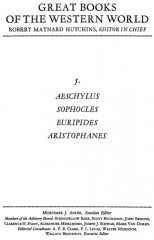
Author : Great Books of the Western World - Hutchins Robert Maynard
Title : Volume 05 Aeschylus Sophocles Euripides Aristophanes
Year : 1952
Link download : Great_Books_of_the_Western_World_-_Volume_05_Aeschylus_Sophocles_Euripides_Aristophanes.zip
BIOGRAPHICAL NOTE. AESCHYLUS the poet was born at Eleusis around the year 525 B.C. His father, Euphorion, belonged to the "Eupatridae," or old nobility, of Athens. Whether Aeschylus was actually initiated into the Eleusinian Mvsteries is not known. The accusation that he divulged the secrets of Demeter has been interpreted both as supporting and as refuting the view that he was an initiate. Aeschylus fought against the Persian invader at Marathon in 490, and he may also have been with the Athenians seven years later at Salamis, and even at Artemisium and Plataea. Some scholars have found in the poet's knowledge of Thracian geography and customs an indication that he took part in one or more of the northern expeditions in the years following the Persian War. The first of Aeschylus' plays was exhibited in 499, only thirty years after the establishment by Peisistratus of the annual contest in tragedy at the festival of the City Dionysia. Thespis, who won the prize at that competition, was called by the ancients the earliest tragic poet. But Aeschylus himself would seem to be the true founder of tragedy, since, according to Aristotle, he first introduced a second actor, diminished the importance of the chorus, and assigned the leading part to the dialogue. Aeschylus' first recorded victory was in 484, when he had been competing for fifteen years. Between that date and the performance of his last work, the Oresteian trilogy and the satyr play Proteus, in 458, he won the prize at least twelve times. He wrote more than ninety plays, of which seven survive. The oldest of these, the Suppliant Maidens, cannot be much later than 490. The Persians, which is the only extant Greek tragedy on an historical subject, was exhibited in 472, the Seven against Thebes in 467, the Prometheus probably not long before 458, the date of the trilogy made up of the Agamemnon, the Choephoroe, and the Eumenides. The plays were exhibited in groups of four-three tragedies and a satyr play. Sometimes, as in the case of the surviving trilogy, but not always, the tragedies formed a dramatic cycle, integrated in fable and in theme. The poet acted in his own plays. According to Aristotle, Aeschylus was charged with impiety for revealing certain parts of the Eleusinian ritual, and defended himself by saying that he was not aware the matter was a secret. But the ancients knew neither the name of the offending play nor the precise nature of what was revealed. A later tradition adds to the fact of the accusa tion, the doubtful details that Aeschylus escaped the fury of the audience by clasping the altar of Dionysus in the theater, and that he was later acquitted by the Court of the Areopagus hecause he had fought bravely at Marathon. The first of Aeschylus' several trips to Sicily appears to have been made some time b~tween 476 and 473. Like Pindar and Simonides he was invited to visit the court of King Hiero of Syracuse. After the eruption of Etna, Hiero had re-established the town of the same name at the base of the mountain. To celebrate the new city and to honor his patron, Aeschylus wrote and produced the Women of Etna. On a second visit to Sicily around 472 the poet is said to have repeated for Hiero the Persians, which had just been crowned with the first prize at Athens. Sometime after 458 he was yet a third time in Sicily. There is little reason to believe the various explanations offered in antiquity for Aeschylus' leaving Athens. Most of them are based upon his supposed envy of the popularity of Sophocles and Simonides, and are made improbable, if not impossible, by known facts and dates. The fable that he met his death from an eagle letting fall a tortoise upon his bald head, presumably mistaking it for a stone upon which to break the animal's shell, may have had its origin in an attempt to interpret the allegorical representation of an apotheosis. Aeschylus died and was buried at Gela in 456. The epitaph inscribed on his tomb is attributed by some to Aeschvlus himself: This memorial stone covers Aeschylus the Athenian, Euphorion's son, who died in wheat-bearing Gela. His famed valor the precinct of Marathon could tell and the long-haired Mede, who knows it well. Shortly after the dea th of Aesch ylus the Athenians passed a decree that his plays should be exhibited at public expense, and that whoever desired to produce one of his plays should "receive a chorus." His tomb became a place of pilgrimage, and in the middle of the fourth century, at the proposal of the orator Lycurgus, his statue was set up in the Theatre of Dionysus at Athens. ...

Demolins Edmond - Saint Louis
Auteur : Demolins Edmond Ouvrage : Saint Louis Année : 19881 Lien de téléchargement :...














